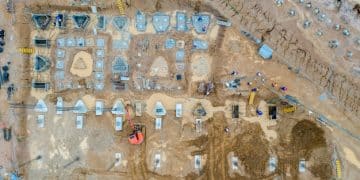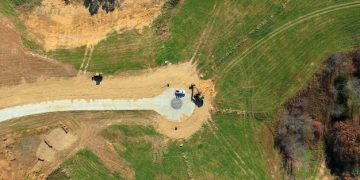US Construction Outlook: Next 12 Months’ Predictions
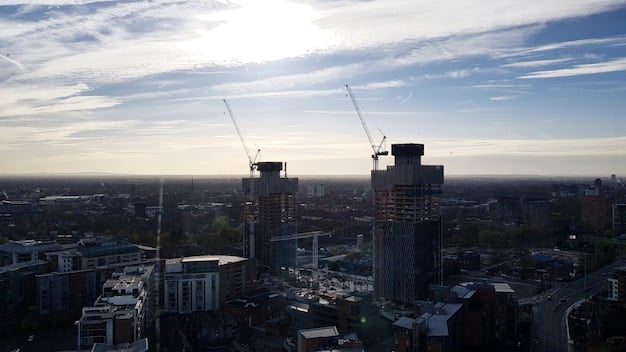
Anúncios
The US construction industry faces a dynamic twelve-month period marked by evolving economic conditions, technological integration, workforce challenges, and sustainability mandates, profoundly shaping future project development and market trends.
The US Construction Industry Outlook: Predictions for the Next 12 Months reveals a sector grappling with both formidable challenges and significant opportunities. As we peer into the immediate future, understanding the forces at play – from economic shifts to technological advancements – becomes paramount for stakeholders looking to build resilience and capitalize on emerging trends. This comprehensive analysis delves into the intricate dynamics shaping the industry, offering insights crucial for strategic planning and sustainable growth.
Economic Headwinds and Tailwinds: The Financial Forecast
The economic landscape for the US construction industry in the coming 12 months is shaped by a confluence of factors, each exerting its unique pressure. Inflationary pressures, though showing signs of easing, continue to impact material costs and labor wages, directly affecting project profitability and budgeting. High interest rates, a tool used to combat inflation, also play a significant role, increasing borrowing costs for developers and potentially slowing down new project starts, particularly in residential and commercial sectors that rely heavily on financing.
Despite these headwinds, certain tailwinds could provide some relief. Government infrastructure spending, driven by initiatives like the Infrastructure Investment and Jobs Act (IIJA), promises a steady stream of projects across transportation, energy, and digital infrastructure. This provides a crucial demand floor, offsetting some of the private sector slowdowns. Furthermore, a resilient job market, despite some cooling, means continued demand for housing and commercial spaces, albeit at a more moderate pace than in recent boom years.
Material Costs and Supply Chains: Navigating Volatility
The volatility in material costs remains a significant concern. While some commodity prices, like steel and lumber, have retreated from their pandemic-era peaks, geopolitical events and ongoing supply chain reconfigurations can introduce sudden price spikes. The industry is still sensitive to disruptions, and unexpected events can quickly strain project budgets and timelines.
- Concrete and cement availability: Regional shortages are a recurring issue.
- Rising energy costs: Directly impacts production and transportation of materials.
- Labor shortages: Increasing labor costs put upward pressure on project bids.
Strategies for mitigating these risks include early procurement agreements, exploring alternative materials, and building stronger relationships with a diverse set of suppliers. Diversifying supply chains geographically can also reduce vulnerability to localized disruptions, enhancing overall project stability.
Interest Rates and Investment Flows: A Tightrope Walk
The Federal Reserve’s stance on interest rates will be a potent determinant of investment in construction. Higher rates compress profit margins for developers and can lead to project deferrals or cancellations. Projects with long lead times and high capital requirements are particularly vulnerable. However, the long-term need for updated infrastructure, housing, and industrial capacity means that investment won’t halt entirely, but rather shift in focus and pace.
Private equity and institutional investors are keenly watching the market. Their decisions on where to deploy capital will heavily influence the types of projects that move forward. Areas perceived as stable, with strong long-term demand fundamentals, such as logistics facilities or data centers, may continue to attract significant investment, even in a higher interest rate environment.
Innovative Technologies: Building Smarter, Not Just Faster
The adoption of innovative technologies is no longer an option but a necessity for the US construction industry, offering pathways to enhanced efficiency, safety, and project delivery. Over the next 12 months, this trend will intensify, with contractors and developers increasingly leveraging digital tools to overcome traditional challenges and gain a competitive edge. From pre-construction planning to on-site execution and post-completion management, technology is reshaping every facet of the building lifecycle.
Digital Transformation: BIM, AI, and Data Analytics
Building Information Modeling (BIM) continues to evolve, moving beyond 3D visualization to encompass 4D (time), 5D (cost), and even 6D (sustainability) dimensions. This integrated approach allows for better collaboration, clash detection, and more accurate project forecasting, reducing costly rework and delays. Artificial Intelligence (AI) is also making inroads, particularly in data analytics, enabling predictive maintenance, optimizing resource allocation, and identifying potential risks before they escalate.
- AI-driven project scheduling: Optimizing timelines and resource use.
- Predictive analytics for risk management: Forecasting potential issues.
- Digital twins: Virtual replicas for real-time monitoring and optimization.
The increased availability of real-time data from construction sites, fed by IoT sensors and drones, fuels these analytical capabilities. Harnessing this data responsibly becomes crucial for making informed decisions and driving continuous improvement across projects.
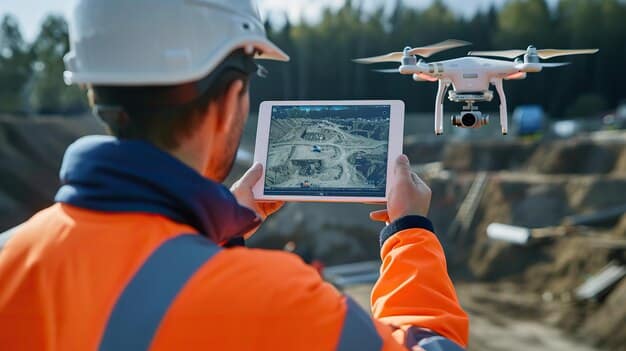
Robotics and Automation: Enhancing Productivity and Safety
Robotics are graduating from experimental phases to practical applications on construction sites. Automated machinery for repetitive tasks like bricklaying, welding, or even rebar tying can significantly boost productivity, reduce labor strain, and improve precision. Exoskeletons are also gaining traction, aiding workers in performing strenuous tasks with less fatigue and reducing injury risks, contributing to a safer work environment.
While full automation of complex construction remains a distant prospect, the integration of specialized robots and automated processes will become more common, particularly in modular construction and off-site prefabrication facilities. This shift not only accelerates project timelines but also addresses some of the persistent labor shortages by augmenting human capabilities rather than replacing them entirely.
The industry’s embrace of innovation isn’t merely about adopting new gadgets; it’s about fundamentally rethinking processes and workflows. Early adopters are already demonstrating the significant benefits, from improved project predictability to enhanced quality and safety. The next 12 months will likely see more companies investing in these technologies as they become more accessible and demonstrable in their return on investment.
Workforce Challenges and Solutions: Building Human Capital
The persistent shortage of skilled labor remains one of the most critical challenges facing the US construction industry. An aging workforce, combined with insufficient new entrants, creates a supply-demand imbalance that drives up labor costs and impacts project timelines. Over the next 12 months, addressing this issue will be paramount for sustaining growth and delivering on ambitious infrastructure and private sector projects.
Attracting and Retaining Talent: A Multi-Generational Approach
Recruiting new talent requires a multi-pronged approach. Marketing the construction industry as a viable and rewarding career path, particularly to younger generations, is essential. Highlighting the integration of technology, the sustainability aspects of modern construction, and opportunities for career progression can make the industry more appealing. Beyond compensation, companies are increasingly focusing on creating attractive work environments, offering professional development, and promoting a positive organizational culture.
- Developing robust apprenticeship programs: Partnering with trade schools and community colleges.
- Investing in upskilling and reskilling current employees: Adapting to new technologies.
- Promoting diversity and inclusion: Expanding the talent pool.
To retain talent, companies need to prioritize employee well-being, offer competitive benefits, and foster a sense of belonging. The “Great Resignation” showed that employees seek more than just a paycheck; they desire purpose, respect, and growth opportunities. Creating clear career pathways and opportunities for continuous learning can significantly reduce turnover.
Training and Skill Development: Bridging the Gap
The gap between available skills and industry needs is widening, particularly with the introduction of new technologies. Traditional training methods need to be augmented with modern approaches. Virtual reality (VR) and augmented reality (AR) are powerful tools for immersive training, allowing new workers to practice complex tasks in a safe, controlled environment. Online modules and micro-credentials can facilitate continuous learning and skill upgrades for the existing workforce.
Collaboration between industry associations, educational institutions, and government agencies is vital for developing relevant curricula and certifications that meet the evolving demands of the construction sector. Companies that invest proactively in training their employees will be better positioned to adopt new technologies, improve productivity, and enhance safety performance, ultimately building a more resilient and capable workforce for the future.
Sustainability and Green Building: A Growing Imperative
Sustainability is rapidly transitioning from a niche concern to a core imperative in the US construction industry. Driven by environmental regulations, client demand, and a growing awareness of climate change, the next 12 months will see an accelerated focus on green building practices, circular economy principles, and achieving net-zero goals. This shift represents not just a compliance requirement but a substantial opportunity for innovation and competitive differentiation.
Eco-Friendly Materials and Methods: Reducing Environmental Footprint
The adoption of eco-friendly materials is gaining momentum. This includes recycled content, low-carbon concrete, sustainably sourced timber, and advanced insulation materials that enhance energy efficiency. The emphasis is on reducing the embodied carbon of buildings—the emissions associated with material extraction, manufacturing, transport, and construction. Beyond materials, construction methods are evolving to be more sustainable.
Modular construction and prefabrication are prime examples, as they often lead to less waste, more efficient use of materials, and reduced on-site disturbances. Water conservation techniques, renewable energy integration (solar panels, geothermal systems), and advanced waste management strategies are also becoming standard practice. These practices not only benefit the environment but can also lead to long-term operational cost savings for building owners.
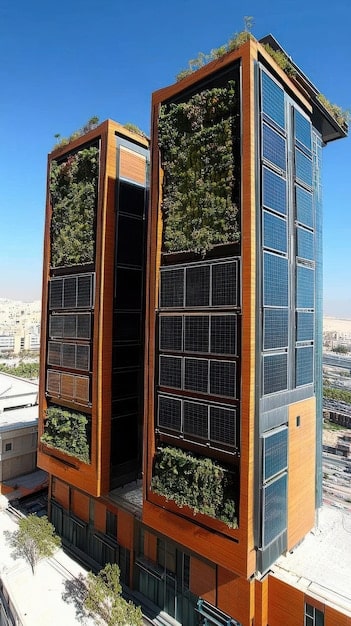
Regulatory Landscape and ESG Pressures: Driving Change
An evolving regulatory landscape, at both federal and state levels, is pushing the industry towards greener practices. Stricter building codes, incentives for energy-efficient construction, and mandates for disclosing environmental performance are becoming more common. Furthermore, Environmental, Social, and Governance (ESG) factors are increasingly influencing investment decisions.
- Stricter carbon emission targets for new builds.
- Increased incentives for LEED-certified projects.
- Disclosure requirements for embodied carbon in materials.
Clients, investors, and even employees are demanding greater transparency and accountability in sustainable practices. Companies that proactively integrate ESG principles into their operations and demonstrate a clear commitment to sustainability will likely attract more desirable projects, secure better financing, and enhance their brand reputation. The next 12 months will be crucial for positioning businesses within this growing green economy.
Infrastructure Investment: Paving the Way Forward
The Infrastructure Investment and Jobs Act (IIJA), signed into law in late 2021, represents a monumental commitment to revitalizing America’s aging infrastructure. Over the next 12 months, the pace of project planning, awarding, and commencement under this act is expected to accelerate significantly, providing a crucial stimulus for the US construction industry. This investment spans various sectors, promising a broad impact across the nation.
Modernizing Transportation Networks: Roads, Bridges, and Transit
A substantial portion of IIJA funding is allocated to modernizing and expanding transportation infrastructure. This includes repairing and upgrading dilapidated roads and bridges, a critical need given the age of much of the existing infrastructure. Investments in public transit systems, including rail and bus networks, aim to improve connectivity and reduce congestion in urban areas. This creates a pipeline of sustained demand for civil engineering firms, heavy equipment operators, and a wide array of construction professionals.
Beyond repair, the focus is also on building more resilient and future-ready transportation assets. This involves adopting materials and designs that can withstand the impacts of climate change, integrating smart highway technologies, and planning for electric vehicle charging infrastructure. The emphasis is not just on volume but on quality and long-term sustainability of these vital networks.
Expanding Digital and Energy Infrastructure: The Future’s Foundation
The IIJA also earmarks significant funds for expanding broadband access across rural and underserved areas, a crucial step in bridging the digital divide. This translates into major trenching and cabling projects, connecting communities to high-speed internet. In the energy sector, investments are targeted at upgrading the electric grid to be more resilient and capable of integrating renewable energy sources. This includes projects related to transmission lines, smart grid technologies, and clean energy generation facilities.
These infrastructure projects are foundational to the nation’s economic competitiveness and quality of life. The predictability of government funding, unlike the more cyclical private sector, offers a degree of stability for construction firms. However, navigating the complexities of federal contracting, environmental reviews, and local stakeholder engagement will be key for companies looking to participate effectively in this historic infrastructure buildout.
Residential and Commercial Sectors: Adapting to Evolving Demand
The residential and commercial construction sectors in the US are undergoing significant shifts, driven by demographic trends, economic conditions, and changing consumer behaviors. Over the next 12 months, these sectors will likely continue to adapt, focusing on specific niches and evolving designs to meet evolving demand patterns, moving away from a one-size-fits-all approach.
Housing Market Adjustments: Affordability and Density
The residential sector, particularly single-family housing, is experiencing a cooling period after years of robust growth, influenced by higher interest rates and affordability constraints. However, underlying demand persists, driven by demographic shifts and a lingering housing supply deficit. The focus is increasingly shifting towards solutions that address affordability, such as build-to-rent communities, smaller footprint homes, and infill developments that increase density in desirable urban and suburban areas.
Multi-family housing projects, especially those offering amenities and connectivity, continue to see demand, albeit with more scrutiny on financing. Developers are also exploring innovative construction methods like prefabrication and modular building to accelerate delivery and reduce costs, making homeownership or quality rental options more accessible. This adaptation involves a strategic balancing act between market demand, available land, and evolving homeowner preferences for flexible living spaces.
Commercial Real Estate Reimagined: Office, Retail, and Industrial
The commercial sector is witnessing a significant transformation. The office market continues to grapple with hybrid work models, leading to a need for reconfigured spaces that emphasize collaboration, flexibility, and wellness. Instead of large, traditional office buildings, there’s a growing demand for smaller, highly amenitized, and technologically advanced spaces. Many older office buildings may explore adaptive reuse, converting them into residential units or mixed-use developments.
Retail construction is focused on experiential centers and last-mile logistics, supporting e-commerce growth. Industrial construction, particularly for warehouses and distribution centers, remains a strong segment, driven by supply chain needs. The next 12 months will see continued strategic investment in industrial facilities, especially those incorporating automation and sustainable features, as businesses seek to optimize their logistical networks and enhance operational efficiency.
Emerging Niche Markets: Specialist Opportunities
Beyond the traditional pillars of residential, commercial, and infrastructure, several niche markets are emerging or expanding rapidly within the US construction industry. These specialized opportunities often leverage unique technological advancements, respond to specific societal needs, or cater to evolving economic patterns. Identifying and strategically targeting these niches can provide robust growth avenues for forward-thinking construction firms over the next 12 months.
Data Centers and Advanced Manufacturing Facilities
The relentless growth of digitalization, cloud computing, and artificial intelligence fuels an insatiable demand for data centers. These highly specialized facilities require precise environmental controls, robust power infrastructure, and rapid construction delivery. Similarly, the reshoring of manufacturing, particularly in high-tech sectors like semiconductors, electric vehicle batteries, and biotech, is driving significant investment in advanced manufacturing plants. These projects are often large-scale, complex, and demand state-of-the-art construction techniques and coordination.
The construction of these facilities is not just about erecting buildings; it involves integrating sophisticated mechanical, electrical, and plumbing systems, often with stringent cleanroom or controlled environment requirements. Firms with expertise in these areas, or those willing to invest in developing such capabilities, will find a steady stream of high-value opportunities.
Lifesciences and Healthcare Infrastructure
The healthcare and life sciences sectors continue to be resilient, propelled by an aging population, ongoing medical research advancements, and the need for modern, flexible healthcare facilities. This includes the construction of new hospitals, specialized clinics, research laboratories, and biopharmaceutical manufacturing plants. These projects are characterized by rigorous regulatory requirements, complex mechanical systems, and a strong emphasis on patient safety and well-being.
The demand for these facilities extends beyond urban centers, with a growing need for accessible healthcare in suburban and rural areas. Design and construction teams capable of delivering highly specialized environments that support cutting-edge medical practices and research will be particularly sought after. The focus often includes integrating technology for operational efficiency and patient experience, making these projects technologically demanding as well.
These niche markets often require a higher degree of specialization, technical expertise, and a robust understanding of sector-specific regulations and client needs. While competitive, they typically offer higher margins and longer-term project pipelines for firms that can successfully navigate their unique complexities, representing a strategic focus for growth in the dynamic US construction landscape.
| Key Area | Outlook Summary |
|---|---|
| 📊 Economic Factors | Inflation eases, but interest rates remain a concern; government infrastructure spending provides crucial support. |
| ⚙️ Technology Adoption | Increased integration of BIM, AI, and robotics for efficiency, safety, and project optimization. |
| 🧑💻 Workforce Solutions | Focus on attracting, training, and retaining skilled labor through modern programs and diversity initiatives. |
| 🌿 Sustainability Drive | Emphasis on green building, eco-friendly materials, and circular economy practices driven by regulations and demand. |
Frequently Asked Questions About the US Construction Outlook
The primary economic factors include ongoing inflationary pressures affecting material and labor costs, and higher interest rates that increase borrowing expenses for projects. However, federal infrastructure spending, particularly from the IIJA, is expected to provide a significant counter-balance by funding numerous public works projects, thereby stabilizing demand in certain sectors.
Innovative technologies such as Building Information Modeling (BIM), AI-driven analytics, and robotics are enhancing efficiency, improving safety, and optimizing resource allocation. These tools facilitate better project planning, reduce waste, and enable more precise execution, fundamentally changing how projects are managed from conception to completion across various construction phases.
Addressing the labor shortage involves multi-faceted strategies, including robust apprenticeship programs, increased investment in upskilling and reskilling the existing workforce, and efforts to attract new talent through marketing and improved work environments. Promoting diversity and inclusion also helps expand the talent pool, aiming to create a more resilient and skilled labor force capable of meeting future demands.
Sustainability and green building will be central, driven by stricter environmental regulations, client demand for eco-friendly structures, and evolving ESG pressures. This includes increased adoption of low-carbon materials, energy-efficient designs, waste reduction strategies, and modular construction, leading to buildings with reduced environmental footprints and long-term operational savings while impacting the US construction landscape significantly.
Infrastructure projects funded by the IIJA, such as roads, bridges, and digital broadband, are expected to see significant activity. In the private sector, growth is anticipated in specialized niches like data centers, advanced manufacturing facilities, and certain healthcare developments, while residential and traditional commercial sectors will focus on adapting to affordability and evolving usage patterns.
Conclusion
The US construction industry stands at a pivotal juncture, poised for a transformative 12 months. While economic fluctuations, particularly interest rates and material costs, will continue to demand careful navigation, the resilience of the sector is underscored by sustained infrastructure investments and the accelerating adoption of innovative technologies. Addressing the critical workforce challenges through comprehensive training and talent retention strategies will be paramount. Concurrently, the industry’s commitment to sustainability and green building practices will not only meet regulatory and client demands but also unlock new avenues for growth and efficiency. By strategically embracing these shifts and investing in both human capital and technological advancements, the US construction industry can fortify its foundations, build resilience against future disruptions, and continue to shape the physical landscape of the nation in meaningful and impactful ways.

